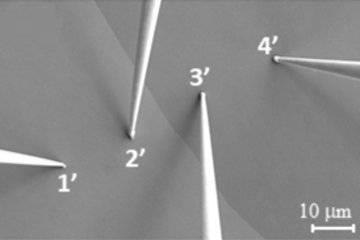All genres
621.
Thesis - PhD
Investigation of crystallographic character and molten-salt-corrosion properties of grain boundaries in a stainless steel using EBSD and ab-initio calculations. Dissertation, Ruhr-Universität Bochum, Bochum, Germany (2017)
622.
Thesis - PhD
Influence of strain path changes during cup drawing on the twinning activity in TWIP steels investigated by ECCI. Dissertation, RWTH Aachen, Aachen, Germany (2017)
623.
Thesis - PhD
A Study on the Microstructure Formation Mechanisms and Functional Properties of CdTe Thin Film Solar Cells Using Correlative Electron Microscopy and Atomistic Simulations. Dissertation, RWTH Aachen, Aachen, Germany (2017)
624.
Thesis - PhD
The Kikuchi bandlet method for the intensity analysis of the Electron Backscatter Kikuchi Diffraction Patterns. Dissertation, RWTH Aachen, Aachen, Germany (2015)
625.
Thesis - PhD
The inheritance of different microstructures found after hot rolling on the properties of a completely annealed dual phase steel. Dissertation, Fakultät für Georessourcen und Materialtechnik, RWTH Aachen, Aachen, Germany (2014)
626.
Thesis - PhD
Feasibility study on local elastic strain measurements with an EBSD pattern cross correlation method in elastic-plastically deforming material. Dissertation, RWTH Aachen, Aachen, Germany (2014)
627.
Thesis - PhD
Relation between microstructure and mechanical properties of a low-alloyed TRIP steel. Dissertation, RWTH Aachen, Aachen, Germany (2013)
628.
Thesis - Diploma
Schädigungsmechanismen und Entwicklung der Mikrostruktur eines Al-legierten TRIP-Stahls im Laufe der Verformung. Diploma, RWTH Aachen, Aachen, Germany (2008)
629.
Thesis - Master
Microstructural Investigations of Heavily Rolled Ni-9at.%W Sheets Designed as Substrate for Superconducting Layers. Master, RWTH Aachen, Aachen, Germany (2018)
630.
Thesis - Master
Investigation on the Influence of Hydrogen on Dislocation Formation during Nanoindentation in TWIP Steels. Master, RWTH Aachen, Aachen, Germany (2018)
631.
Thesis - Master
3-dimensional investigation of the crystallographic prior-austenite grain boundary characters in martensitic steels. Master, RWTH Aachen, Aachen, Germany (2018)
632.
Thesis - Bachelor
Experimentelle Untersuchung kristallographischer Aspekte der Rekristallisation von reinem Magnesium. Bachelor, FH Düsseldorf, Düsseldorf [Germany] (2007)
633.
Report
Texture analysis of a coarse grained Fe3Al cast alloy by neutron scattering. MPI für Eisenforschung GmbH, Düsseldorf, Germany (2004)
634.
Report
Plastic deformation of aluminium-bicrystals. (2004)
635.
Report
Experimental investigation of the deformation behavior of aluminium-bicrystals. MPI für Eisenforschung GmbH, Düsseldorf, Germany (2004)
636.
Report
Mikrotexturmessung am Max-Planck-Institut für Eisenforschung. (2004)
637.
Other
Group for Microscopy and Diffraction, (2004)
638.
Other
Study on the deformation behaviour of aluminium bicrystals by use of image correlation photogrammetry, (2003)











